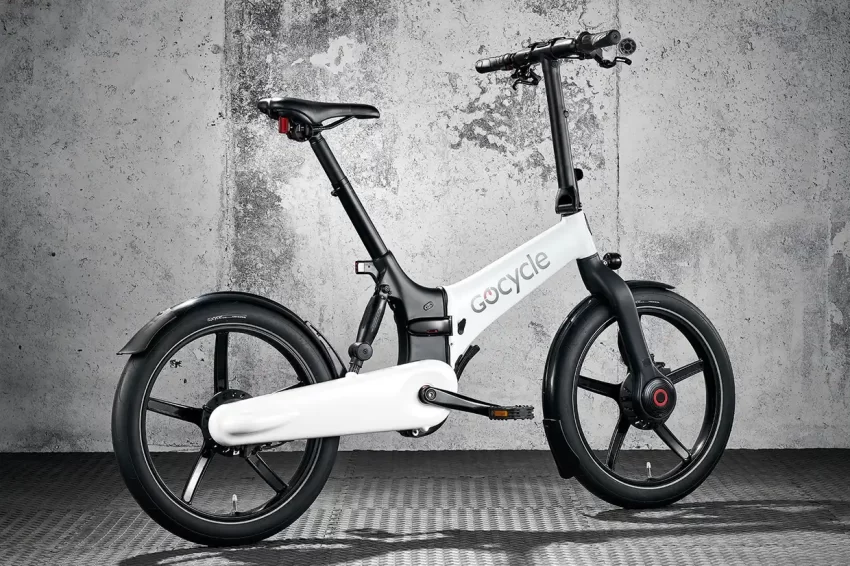GoCycle G4 review
GoCycle is a genuine British success story. Its founder Richard Thorpe started out life as Formula 1 engineer for McLaren before designing the original G3 GoCycle a decade ago.
The commitment to the single-sided frame and fork, and small wheels wrapped around clever electronics continues, and the latest foldable G4 now features a full-carbon fork and a carbon mid-section, helping to shed weight.
Its near-£4,000 price tag gets you a no-compromise folding electric bike with a more powerful updated motor and the brand’s own app, as well as practical extras including lights and mudguards.
The G4’s single-sided design not only makes the fold compact, but the stub axles mean you don’t need to remove a wheel to fix a puncture. Although, with toughened tyres over two inches wide, punctures aren’t that likely anyway.
The GoCycle’s rear-end swingarm pivots at the bottom bracket and is suspended from the main frame via a one-inch-travel shock. The swingarm is made from magnesium alloy, and as well as being a structural part of the bike, it encloses the ‘Cleandrive’ drivetrain.
The design is clean as well as neat, which is also true of the GoCycle’s proprietary hydraulic disc brakes, both of which feature rotor covers. The braking is superb, with well-shaped levers and bags of power.
The three-speed Shimano Nexus hub gear delivers a 39.1-72.5in range that I found ideal for suburban and urban riding.
The bottom gear is low enough for steep climbs, the 53.3in middle gear enables you to go at a fair lick, and the top is big enough to power you along at speeds close to that of a road bike.
GoCycle’s newly updated motor provides more power than the previous generation’s version, and because the GoCycle isn’t a ‘hands-on’ system you have to rely on the bike’s programming and speed/cadence monitoring for it to judge how much power you require.
However, a small bar-mounted button does enable you to override the assistance should you want more of a boost at the start of a climb or when pulling away from traffic lights.
The GoCycle is at its best when used with its own app. This has lots of editable tuning options and its comprehensive display info includes the average power you and the bike are producing, as well as how much fuel you’re saving by not driving – one of the key benefits of riding an electric bike.
GoCycle doesn’t state a torque output for the G4, but the constantly changing power output delivers from the equivalent of 20Nm up to around 70Nm.
What quickly becomes apparent is just how impressive the G4 is.
Plenty of torque and small wheels deliver rapid acceleration, making it feel nippier than some of the best electric bikes we’ve tested and well suited to city rides. And yet, thanks to its big tyres, suspension and traction control, it can also tackle rural riding on rougher surfaces.
GoCycle claims a range of up to 40 miles / 65km, but the most I managed was 33.55 miles / 54km.
Where I live is quite hilly, though, so that figure included 1,343ft / 409m of climbing. However, a range of more than 50km is more than enough for all but the longest commutes, and a charge time of just three hours is impressive.
The G4 may be nippy but it’s also stable. It has a full-length 1,065mm wheelbase, a relaxed 70-degree head angle and its very slack 68-degree seat angle means that, as you extend the telescopic seatpost, the saddle-to-bar distance increases significantly so the riding position isn’t cramped.
The result is a ride that’s a world away from the twitchiness often associated with most small-wheeled folders. Two different-length seatpost extensions also meant it fitted both me and my much shorter partner.
Its 830x370x750mm folded size is small enough to fit the boot of a small car, but it’s not compact enough to slide under a typical desk. A Brompton electric would be possibly be a better choice for you if space is a key issue for you.
I really, really like the G4, thanks to its unique, no-compromise design that’s perfect for its purpose. However, while it’s lighter and more powerful than before, it’s also more expensive.
This wasn’t helped by production costs pushing the price up from £3,399 when we first requested the bike to its present price of £3,999 – though this does now include lights and mudguards, both of which I consider commuting essentials.






